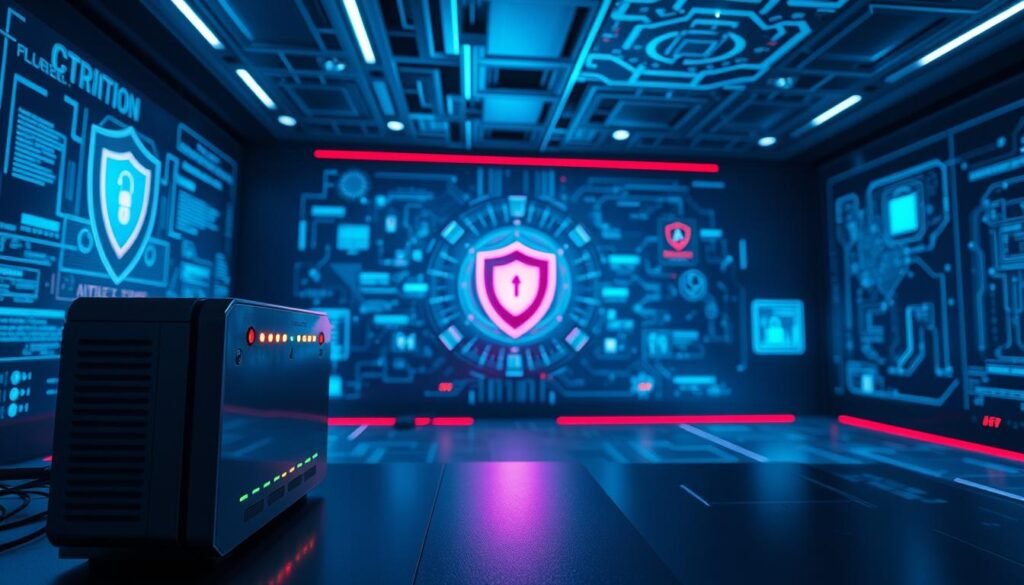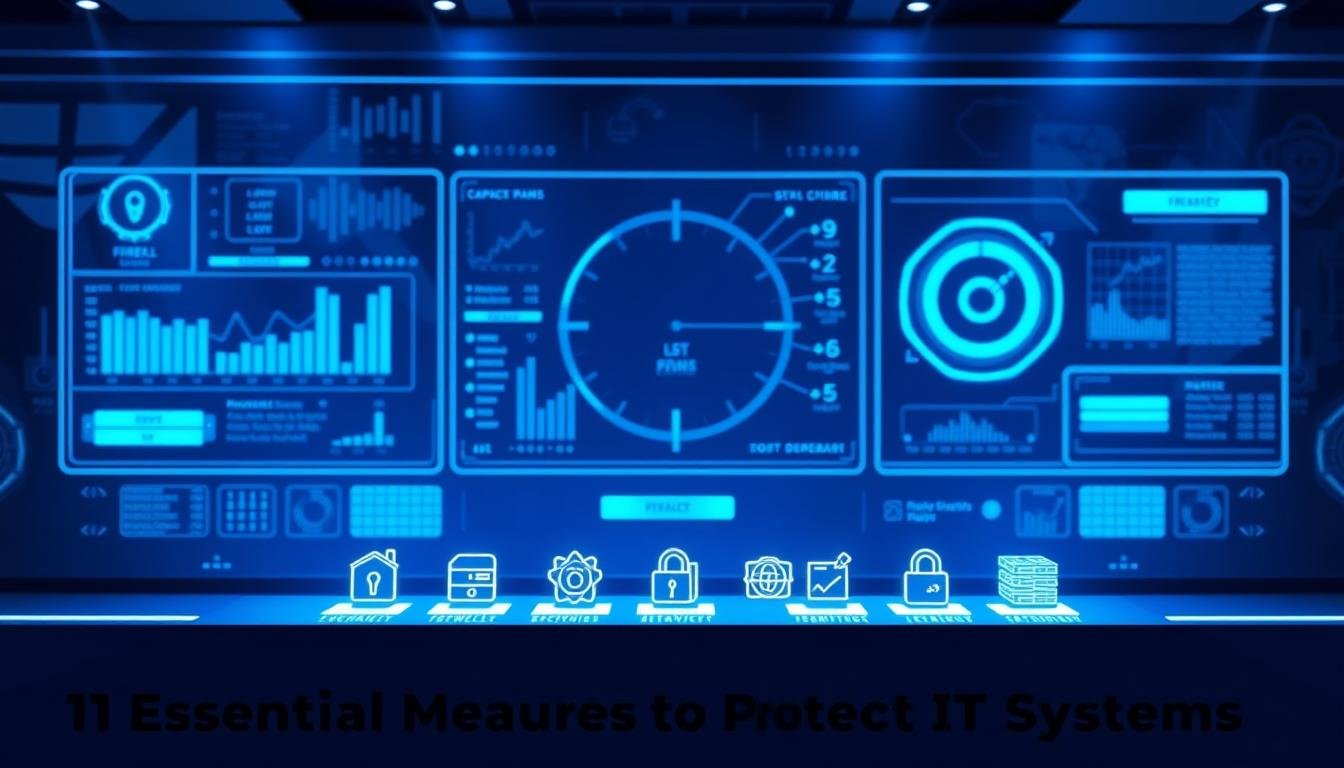A staggering 60% of small businesses cease operations within six months post-cyber attack, underscoring the imperative for robust IT system protection. In today’s digital realm, the implementation of 11 practical methods to safeguard your IT systems is not a luxury but a necessity. By integrating effective cybersecurity strategies into your approach, you can substantially diminish the risk of cyber threats, ensuring the integrity of your systems.
In the digital age, safeguarding your IT systems is paramount. By adhering to 11 practical methods to safeguard your IT systems, you can guarantee the security and integrity of your IT systems. The adoption of cybersecurity tips and best practices can significantly reduce the risk of cyber attacks, shielding your business from potential threats.
Introduction to IT System Protection
Understanding the significance of IT system protection and implementing effective cybersecurity measures is vital for safeguarding your business against cyber threats. This article delves into the essential measures to protect your IT systems, encompassing cybersecurity tips and best practices.
Key Takeaways
- Implementing 11 practical ways to keep your IT systems safe and secure can mitigate cyber threats
- Cybersecurity tips and best practices are essential for protecting IT systems
- 60% of small businesses shut down within six months of a cyber attack
- Robust IT system protection is critical for businesses in today’s digital landscape
- Effective cybersecurity measures can ensure the integrity of your IT systems
- Regular security audits and updates are crucial for protecting IT systems
1. Conduct Regular Security Audits
Regular security audits are vital for maintaining IT security standards. They help uncover vulnerabilities and weaknesses in your systems. Through these audits, you can evaluate your organization’s security posture and pinpoint areas for enhancement. This step is critical for implementing robust network protection strategies.
Understanding what to look for during a security audit is paramount. This includes common vulnerabilities such as outdated software, weak passwords, and unsecured networks. For a detailed guide on the audit process, refer to a cybersecurity audit resource. It offers insights and practical tips for a comprehensive audit.
Key areas to concentrate on during a security audit include:
- Network configuration and security
- System and software updates
- User access and authentication
By adhering to these guidelines and integrating IT security best practices into your network protection strategies, you can substantially lower security breach risks. This ensures the integrity and security of your IT systems.
2. Implement Strong Password Policies
Implementing robust password policies is critical for safeguarding your IT systems against cyber threats. Weak passwords are vulnerable to hackers, allowing them unauthorized access to your systems and data. Thus, strong password policies are a fundamental data security measure to thwart cyber threats.
A sound password policy mandates guidelines for password creation, such as combining uppercase and lowercase letters, numbers, and special characters. For further insights on password policies, refer to password policy best practices. Incorporating two-factor authentication further enhances your password policy, rendering it more challenging for hackers to breach your systems.
Key aspects to consider when establishing strong password policies include:
- Regularly updating and changing passwords
- Using unique passwords for each account
- Avoiding easily guessable information, such as birthdays or common words
By enforcing strong password policies, you can markedly diminish the likelihood of password-related security breaches. This enhances your overall cyber threat prevention strategy. It is a pivotal step in fortifying your IT systems and data against potential threats.
3. Keep Software Up to Date
Ensuring your software is current is paramount for safe IT practices and secure system maintenance. Outdated software exposes your systems to security risks, as hackers target known vulnerabilities in older versions. Regular updates safeguard your systems against these threats.
Several advantages come from maintaining updated software:
- Improved security: Updates often include patches for known vulnerabilities.
- Enhanced performance: Updates can boost your software’s performance and efficiency.
- New features: Updates introduce new functionalities that enhance your user experience.
Importance of Timely Updates
Timely updates are critical for the security and integrity of your IT systems. Keeping your software current ensures protection against known vulnerabilities. It also grants access to the latest features and functionalities.
4. Use Firewalls and Antivirus Software

Implementing robust cybersecurity measures is essential for safeguarding your IT systems against various threats. Utilizing firewalls and antivirus software is an effective strategy. Firewalls act as barriers, blocking unauthorized access to your systems. Antivirus software, on the other hand, detects and eradicates malware. By integrating these network protection strategies, you can substantially diminish the risk of security breaches and safeguard your systems against malware.
To initiate, refer to this resource for insights on constructing a robust cybersecurity strategy. When selecting antivirus solutions, consider aspects such as ease of use, compatibility, and customer support. Norton, McAfee, and Kaspersky are among the most popular antivirus software options.
Here are some best practices for configuring firewalls and antivirus software:
- Enable firewall protection for all networks, including public and private ones.
- Regularly update your antivirus software to ensure you have the latest security patches.
- Use strong passwords and enable two-factor authentication for added security.
By adhering to these cybersecurity tips and implementing effective network protection strategies, you can fortify your IT systems and shield your business from potential threats.
5. Educate Your Team on Cybersecurity
Empowering your team with knowledge on cyber threat prevention is crucial for maintaining the security and integrity of your IT systems. By educating your team on IT security best practices, you can reduce the risk of security breaches. This creates a culture of cybersecurity awareness.
Regular training sessions can help your team identify and report potential security threats. These sessions cover topics such as phishing awareness, password management, and safe internet practices. For instance, you can provide cybersecurity awareness training to educate your team on the latest threats and best practices.
Topics to Cover in Training Sessions
- Phishing awareness and prevention
- Password management and security
- Safe internet practices and online security
Encouraging Reporting of Suspicious Activity
Encouraging your team to report suspicious activity is essential for preventing security breaches. By fostering a culture of cybersecurity awareness, you empower your team to actively protect your IT systems.
6. Backup Your Data Regularly

Implementing a robust backup strategy is essential for safeguarding your IT systems against potential threats. By adopting safe IT practices, you can maintain the integrity and availability of your data. Regular backups are vital for data recovery in the event of a security breach, hardware failure, or natural disaster.
Exploring various backup options is crucial. You can opt for cloud or local backup solutions, each with unique benefits and drawbacks. Cloud backup solutions offer flexibility and scalability, whereas local backup solutions provide greater control over your data.
- Backing up your data regularly, ideally daily or weekly
- Using a combination of cloud and local backup solutions
- Testing your backups regularly to ensure they are working correctly
Adopting these best practices and adhering to safe IT practices is key to protecting your data and ensuring business continuity. Always prioritize data security measures to safeguard your IT systems.
7. Limit User Access Privileges
Limiting user access privileges is a critical step in safeguarding your IT systems’ security and integrity. This action significantly reduces the risk of insider threats and unauthorized access to sensitive data. It is a fundamental aspect of cybersecurity tips aimed at shielding your organization from potential security breaches.
Adopting secure system maintenance practices, such as role-based access control, is essential. It ensures users have only the access required for their job functions. Roles are assigned based on job responsibilities, for instance:
- Administrators possess full system access, enabling them to make necessary changes.
- Managers have read-only access to specific system areas, allowing them to view reports.
- Employees are granted limited access to only the system areas required for their job duties.
It is also vital to regularly review user permissions to ensure they remain current and relevant. This can be achieved through a systematic review process, such as quarterly or bi-annually. This allows for verification of user access and any necessary adjustments.
By adhering to these cybersecurity tips and implementing secure system maintenance practices, you can effectively safeguard your organization against potential security threats. This ensures the integrity and security of your IT systems.
8. Monitor Network Traffic
Monitoring network traffic is a critical component of network protection strategies. It facilitates the detection and mitigation of potential security threats. By vigilantly observing network activity, one can identify and thwart cyber threat prevention efforts from being undermined.
To effectively monitor network traffic, the deployment of appropriate tools is imperative. Several options stand out, including:
- Network intrusion detection systems (NIDS)
- Network protocol analyzers
- Log management software
Understanding what to scrutinize in logs is crucial. This encompasses suspicious activity, such as uncharacteristic login attempts or substantial data transfers. Promptly addressing anomalous behavior is essential to forestall security breaches and safeguard IT systems.
Consistent network traffic monitoring is indispensable for cyber threat prevention and network protection strategies. It empowers you to preempt potential security threats and maintain the integrity of your IT infrastructure.
9. Utilize Encryption for Sensitive Information
Encryption is a vital component of data security measures, safeguarding sensitive information from unauthorized access. It ensures the confidentiality and integrity of data, crucial for maintaining customer trust and adhering to regulatory mandates.
Adopting safe IT practices like encryption can be done through various methods. Symmetric encryption employs a single key for both encryption and decryption. In contrast, asymmetric encryption utilizes a pair of keys: one for encryption and another for decryption.
Specific data types that necessitate encryption include:
- Personal identifiable information (PII)
- Financial data
- Confidential business information
Effective encryption practices involve the use of secure protocols, such as HTTPS. Regular updates to encryption software are also necessary to apply the latest security patches. Familiarity with compliance standards, like those in the General Data Protection Regulation (GDPR), is critical. It ensures that encryption methods align with regulatory expectations.
10. Develop an Incident Response Plan
Creating a robust incident response plan is crucial for any organization. It enables swift and effective handling of security incidents, thus reducing downtime and data loss. This plan ensures readiness to address security breaches and their consequences. By adhering to cybersecurity tips and practicing secure system maintenance, the risk of security incidents can be significantly lowered.
An effective incident response plan encompasses several critical components. These include incident detection, containment, and eradication. A clear communication strategy is also vital to keep all stakeholders informed. Key elements to focus on include:
- Incident classification and prioritization
- Incident response team roles and responsibilities
- Communication and notification procedures
- Incident containment and eradication strategies
Regularly testing and updating your incident response plan is essential for its effectiveness. This involves conducting tabletop exercises, simulations, and reviews to pinpoint areas for enhancement. By adhering to these cybersecurity tips and maintaining secure system maintenance, your organization can safeguard against security threats and mitigate the effects of security incidents.
11. Stay Informed About Emerging Threats
In the dynamic world of IT security, staying informed is paramount. Being proactive and knowledgeable about potential threats enables organizations to safeguard their systems and data effectively. This necessitates a commitment to regularly update oneself on the latest IT security best practices and tech security guidelines.
Resources for Cyber Threat Intelligence
Accessing cybersecurity reports and threat intelligence feeds is essential. These resources offer invaluable insights into emerging threats. They empower organizations to comprehend the nature of potential threats and implement preventive measures, adhering to IT security best practices.
Industry Engagement
Participating in the cybersecurity community through industry groups and conferences is also crucial. These platforms serve as venues for learning from experts and sharing knowledge on the latest tech security guidelines and strategies for mitigating threats.
By embracing these strategies, organizations can effectively counter emerging threats. This ensures the integrity and security of their IT systems, aligning with recommended IT security best practices and tech security guidelines.
